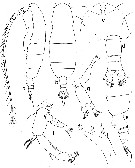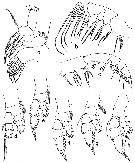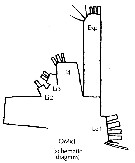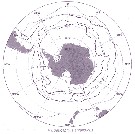|
|
 |
|
Calanoida ( Order ) |
|
|
|
Arietelloidea ( Superfamily ) |
|
|
|
Augaptilidae ( Family ) |
|
|
|
Euaugaptilus ( Genus ) |
|
|
| |
Euaugaptilus antarcticus (Wolfenden, 1911) (F,M) | |
| | | | | | | Syn.: | Augaptilus antarcticus Wolfenden, 1911 (p.334, figs.F,M); Sewell, 1948 (p.575);
no Euaugaptilus laticeps : Farran, 1929 (p.269); Vervoort, 1957 (p.139); Tanaka & Omori, 1987 (p.252) | | | | Ref.: | | | Matthews, 1972 (p.28, 33: Rem., 60); Boxshall, 1985 (p.306, Rem.); Park, 1993 (p.32, figs.F,M, Rem.); Bradford-Grieve & al., 1999 (p.882, 939, fig.F); Bradford-Grieve, 1999 b ( p.48, figs.F,M, Rem.: p.54, figs.171, 190) |  issued from : T. Park in Biology of the Antarctic Seas, XXII. Antarct. Res. Ser., Washington, 58. [p.33, Fig.23]. Female: a-b, habitus (lateral and dorsal, respectively); c, forehead (ventral); d-e, urosome (dorsal and lateral, respectively); f, A2; g, Md; h, Md (biting edge). Nota: Prosome about 2.8 times as long as wide. Forehead broadly round when viewed dorsally or laterally. Rostrum consisting of 2 filaments of medium size. Urosome about 25 % lengt of prosome. Genital segment (dorsally) about as long as wide, widest close to proximal end, about 38 % length of urosome.measured along lateral side, 3rd urosomam segment about 1.6 times length of 2nd, and about 82 % length of caudal ramus. A1 extending beyond distal end of caudal ramus by last 5 or 6 segments. A2: oxa and basis with 1 and 2 well-developed setae, respectively.1st endopodal segment with 1 seta and about 90 % length of basis; 2nd endopodal segment about 71 % length of 1st, with 8 and 6 setae on inner and outer lobe, respectively; exopod about 94 % length 1st endopodal segment; first 7 segments without setae; 8th segment with 4 terminal setae. Mandibular blade with 3 pairs of teeth in addition to 1 relatively small proximal tooth, basal spine absent; palp about 77 % length of blade; endopod extending beyond distal end of exopod by 1/5 its length, with 6 terminal setae; exopod with 4 setae.
|
 issued from : T. Park in Biology of the Antarctic Seas, XXII. Antarct. Res. Ser., Washington, 58. [p.34, Fig.24]. Female: a, Mx1; b, Mx2; c, Mxp; d-h, P1 to P5 (anterior views). Nota: Mx1 with 10 spines on 1st, 1 spiniform seta on 2nd, and 2 setae on 3rd inner lobe; 3 setae on basis; 6 setae on exopod, and 6 setae on outer lobe, 2nd seta from proximal end smallest; endopod absent. Mx2: 6 protopodal lobes with 3, 2, 2, 3, 2, 3 setae (from proximal to distal); endopod with 7 setae. Mxp: basis with 2 pairs of setae; endopod 5-segmented with 4, 4, 3, 3, 4 setae (from proximal to distal). Swimming legs similar to those of E. laticeps except: P1 exopod with 1st outer spine reaching distal end of 2nd, 2 outer spines of 3rd segment very close to each other. P2 exopod with terminal spine of 3rd segment about 94 % length of segment itself. P3 and P4 exopods each with 3 sensory pores, one each at base of 2nd, 3rd, and 5th outer spine; terminal spine of 3rd exopodal segment about 60 % lenth of segment in both legs. P5 with outer seta of basis reaching about distal end of 2nd exopodal segment; exopod with 2 sensory pores, 1 each at base of 2nd and 4th outer spine; terminal spine of 3rd segment about 80 % length of segment itself.
|
 issued from : T. Park in Biology of the Antarctic Seas, XXII. Antarct. Res. Ser., Washington, 58. [p.35, Fig.25]. Male: a, habitus (lateral); b, urosome (dorsal); c, A2; d, P5 (posterior). Nota: Urosome about 28 % length of prosome, and its 5 segments and caudal ramus with length of ratios of 17.9:15.8:11.6:10.5: 15.8:28.4 = 100 (measured along lateral side). Cephalic appendages and first 4 pairs of swimming legs as in female except for some minor differences in proportional lengths of component parts
|
 issued from : R.N. Wolfenden in Die Marinen Copepoden der Deutschen Südpolar-Expedition 1901-1903, 1911. [p.335, Fig.70]. As Augaptilus antarcticus. Female: a, A2; b, Mx1; c, Mxp; d, Md (mandibular palp). Male: e, right P5; f, left P5 (segments 2-3 endopodite). Nota: Right P5 with 2nd and 3rd segments of expoppod not completely separatd. Left P5 with a short outgrowth on the inner margin of 2nd segment.
|
 issued from : J.M. Bradford-Grieve, E.L. Markhaseva & C.E.F. Rocha & B. Abiahy in South Atlantic Zooplankton, Edit. D. Boltovskoy. 1999, Vol.2. Copepoda. [p.1036, Fig. 7.243]. Female: Mx1 (schematic diagram). Li = inner lobe; Le = outer lobe; End = endopodite. Nota: Exp of Mx1 with 6 setae. Cephalothorx in dorsal view with obvious indentation posterior to A2. Md palp almost as long as gnathobase; gnathobade expanded distally.
| | | | | Compl. Ref.: | | | Schnack-Schiel & al., 2008 (p.1045: Tab.2); Park Ferrari, 2009 (p.143, Table 3, 7: common deepwater species, Appendix 1, biogeography); Kouwenberg & al., 2014 (p.290, biogeography, Map 1) | | | | NZ: | 1 | | |
|
Distribution map of Euaugaptilus antarcticus by geographical zones
|
| | | | | |  Issued from : J.H.M. Kouwenberg, C. Razouls & N. Desreumaux in Biogeographic Atlas of the Southern Ocean, Scient. Comm. Antarct. Res., Cambridge, 2014, 6.6. [p.291, Map 1]. Issued from : J.H.M. Kouwenberg, C. Razouls & N. Desreumaux in Biogeographic Atlas of the Southern Ocean, Scient. Comm. Antarct. Res., Cambridge, 2014, 6.6. [p.291, Map 1].
Distribution of Euaugaptilus antarcticus. |
| | | | Loc: | | | Antarct. (W Weddell Sea, South of the Antarctic Convergence: Atlant., Indian, Pacif.) | | | | N: | 6 | | | | Lg.: | | | (10) F: 8,55; M: 9,5; (25) F: 10,13-8,6; M: 9,69; (35) F: 10-9,4; M: 8,3; (48) F: 10,33-9,16; M: 9,83-9,16; {F: 8,55-10,33; M: 9,16-9,83} | | | | Rem.: | Meso-bathypelagic. According to Matthews (1972, p.33) the synonymy of Augaptilus antarcticus with Euaugaptilus laticeps was suggested by Farran (1929) and by Sewell (1932, 1947) and accepted by Vervoort (1957). In the apparent absence of Wolfenden's type material it is impossible to be conclusive. The recorded body proportions are a little different and Wolfenden descibed 7 segments in the exopodite of A2, against 8 in E. laticeps. The first of these differences may be accounted for by narural variation or shrinkage at fixation, the second may be an error of observation. In all other recorded characters there seems to be little or no difference.
Park (1993, p.37) does not admit the synonymy with Euaugaptilus laticeps in E. placitus. Cf. Euaugaptilus placitus (rule of precedence). However, Bradford-Grieve (1999 b, p.48, 54) does not follow Park's opinion.
For Park (1993, p.37) main differences by which E. antarcticus is distinguished from E. laticeps are as follows: in Md of antarcticus, the mandibular blade is widening distally to form a toothed edge, not tapering smoothly as in laticeps; Md palp relatively large compared with blade (about 77 % length of blade in antarcticus and about 43 % length of blade in laticeps). In Mx1, 1st lobe with 10 spines, the 2nd inner lobe with 1 seta, the exopod is with 6 setae, and the outer lobe is with 6 setae. These parts of laticeps have 11, 2, 7 and 9 spines or setae. The 3rd and 4th leg exopods are each with 3 sensory pores, and yhe P5 exopod is with 2 sensory pores, while the same exopods have 2 and 1 sensory pore, respectively, in laticeps. | | | Last update : 22/01/2016 | |
|
|
 Any use of this site for a publication will be mentioned with the following reference : Any use of this site for a publication will be mentioned with the following reference :
Razouls C., Desreumaux N., Kouwenberg J. and de Bovée F., 2005-2026. - Biodiversity of Marine Planktonic Copepods (morphology, geographical distribution and biological data). Sorbonne University, CNRS. Available at http://copepodes.obs-banyuls.fr/en [Accessed January 16, 2026] © copyright 2005-2026 Sorbonne University, CNRS
|
|
 |
 |









